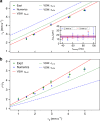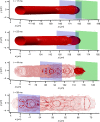Dissipative shock waves generated by a quantum-mechanical piston
- PMID: 30405131
- PMCID: PMC6220177
- DOI: 10.1038/s41467-018-07147-4
Dissipative shock waves generated by a quantum-mechanical piston
Abstract
The piston shock problem is a prototypical example of strongly nonlinear fluid flow that enables the experimental exploration of fluid dynamics in extreme regimes. Here we investigate this problem for a nominally dissipationless, superfluid Bose-Einstein condensate and observe rich dynamics including the formation of a plateau region, a non-expanding shock front, and rarefaction waves. Many aspects of the observed dynamics follow predictions of classical dissipative-rather than superfluid dispersive-shock theory. The emergence of dissipative-like dynamics is attributed to the decay of large amplitude excitations at the shock front into turbulent vortex excitations, which allow us to invoke an eddy viscosity hypothesis. Our experimental observations are accompanied by numerical simulations of the mean-field, Gross-Pitaevskii equation that exhibit quantitative agreement with no fitting parameters. This work provides an avenue for the investigation of quantum shock waves and turbulence in channel geometries, which are currently the focus of intense research efforts.
Conflict of interest statement
The authors declare no competing interests.
Figures







References
-
- Kevrekidis, P. G., Frantzeskakis, D. J. & Carretero-González, R. Emergent Nonlinear Phenomena in Bose-Einstein Condensates: Theory and Experiment (Springer, Berlin, Heidelberg, 2008).
-
- El GA, Hoefer MA. Dispersive shock waves and modulation theory. Phys. D. 2016;333:11–65. doi: 10.1016/j.physd.2016.04.006. - DOI
-
- Donnelly RJ, Swanson CE. Quantum turbulence. J. Fluid. Mech. 1986;173:387–429. doi: 10.1017/S0022112086001210. - DOI
-
- Barenghi, C. F., Donnelly, R. J. & Vinen, W. F. Quantized Vortex Dynamics and Superfluid Turbulence 1st edn (Springer, Berlin, Heidelberg, 2001).
-
- Bradley AS, Anderson BP. Energy spectra of vortex distributions in two-dimensional quantum turbulence. Phys. Rev. X. 2012;2:041001.
Publication types
LinkOut - more resources
Full Text Sources

